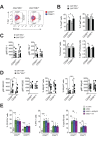CD56-negative NK cells with impaired effector function expand in CMV and EBV co-infected healthy donors with age
- PMID: 30686790
- PMCID: PMC6366961
- DOI: 10.18632/aging.101774
CD56-negative NK cells with impaired effector function expand in CMV and EBV co-infected healthy donors with age
Abstract
Natural killer cells lacking expression of CD56 (CD56neg NK cells) have been described in chronic HIV and hepatitis C virus infection. Features and functions of CD56neg NK cells in the context of latent infection with CMV and / or EBV with age are not known. In a cohort of healthy donors >60 years of age, we found that co-infection with CMV and EBV drives expansion of CD56neg NK cells. Functionally, CD56neg NK cells displayed reduced cytotoxic capacity and IFN-γ production, a feature that was enhanced with CMV / EBV co-infection. Further, the frequency of CD56neg NK cells correlated with accumulation of end-stage-differentiated T cells and a reduced CD4 / CD8 T cell ratio, reflecting an immune risk profile. CD56neg NK cells had a mature phenotype characterized by low CD57 and KIR expression and lacked characteristics of cell senescence. No changes in their activating NK cell receptor expression, and no upregulation of the negative co-stimulation receptors PD-1 or TIM-3 were observed. In all, our data identify expansion of dysfunctional CD56neg NK cells in CMV+EBV+ elderly individuals suggesting that these cells may function as shape-shifters of cellular immunity and argue for a previously unrecognized role of EBV in mediating immune risk in the elderly.
Keywords: CD56-negative; CMV; EBV; NK cells; aging; exhaustion; senescence.
Conflict of interest statement
Figures



References
-
- Hjalgrim H, Friborg J, Melbye M. (2007). The epidemiology of EBV and its association with malignant disease. In: Arvin A, Campadelli-Fiume G, Mocarski E, Moore PS, Roizman B, Whitley R and Yamanishi K, eds. Human Herpesviruses: Biology, Therapy, and Immunoprophylaxis. (Cambridge). - PubMed
-
- Olsson J, Wikby A, Johansson B, Löfgren S, Nilsson BO, Ferguson FG. Age-related change in peripheral blood T-lymphocyte subpopulations and cytomegalovirus infection in the very old: the Swedish longitudinal OCTO immune study. Mech Ageing Dev. 2000; 121:187–201. 10.1016/S0047-6374(00)00210-4 - DOI - PubMed
Publication types
MeSH terms
Substances
Grants and funding
LinkOut - more resources
Full Text Sources
Medical
Research Materials
Miscellaneous

